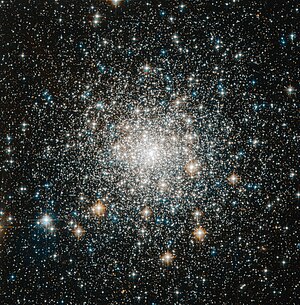Loading AI tools
Globular cluster in the constellation Sagittarius From Wikipedia, the free encyclopedia
Messier 70 or M70, also known as NGC 6681, is a globular cluster of stars to be found in the south of Sagittarius.[lower-alpha 1] It was discovered by Charles Messier in 1780.[lower-alpha 2][6] The famous comet Hale–Bopp was discovered near this cluster in 1995.[10][lower-alpha 3]
| Messier 70 | |
|---|---|
 Globular cluster Messier 70 by Hubble Space Telescope; 3.3′ view | |
| Observation data (J2000 epoch) | |
| Class | V[1] |
| Constellation | Sagittarius |
| Right ascension | 18h 43m 12.76s[2] |
| Declination | –32° 17′ 31.6″[3] |
| Distance | 29.4 kly (9.0 kpc)[4] |
| Apparent magnitude (V) | 7.9[5] |
| Apparent dimensions (V) | 8.0′[6] |
| Physical characteristics | |
| Mass | 1.79×105[4] M☉ |
| Radius | 34 ly[7] |
| Tidal radius | 11.2′[8] |
| Metallicity | = –1.35[9] dex |
| Estimated age | 12.80 Gyr[9] |
| Other designations | GCl 101, M70, NGC 6681[3] |
It is about 29,400[4] light years away from Earth and around 6,500 light-years[11] from the Galactic Center. It is roughly the same size and luminosity as its neighbour in space, M69.[12] M70 has a very small core radius of 0.22 ly (0.068 pc)[13] and a half-light radius of 182.0 ly (55.80 pc).[14] This cluster has undergone core collapse, leaving it centrally concentrated[15] with the luminosity distribution following a power law.[11]
There are two distinct stellar populations in the cluster, with each displaying unique abundances. These likely represent different generations of stars.[16] Five known variable stars lie within the broadest radius, the tidal radius, of it, all of which are RR Lyrae variables.[8][17] The cluster may have two blue stragglers near the core.[11]
Seamless Wikipedia browsing. On steroids.
Every time you click a link to Wikipedia, Wiktionary or Wikiquote in your browser's search results, it will show the modern Wikiwand interface.
Wikiwand extension is a five stars, simple, with minimum permission required to keep your browsing private, safe and transparent.